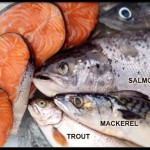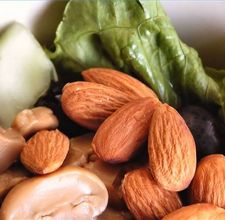Nutrition
Men’s Health Chinese Forum
Date: Saturday, September 10, 2011
Time: 9:30 am – 12:30 pm
Place: Choi Hall, S.U.C.C.E.S.S. Social Service Centre (28 West Pender St., Vancouver)
Programs:
Topic 1: Prostate, colorectal and testicular cancers – its prevention, symptoms, screening, and treatment     Speaker: Dr. Alphonsus Hui
Topic 2:  Nutrition and Cancer     Speaker: Rosalie Lung, Registered Dietitian
- Information Display
- Free healthy living and cancer prevention information
Registration and enquiry:Â 604-215-5204Â Lee Ma
 The omega-3 fatty acids play an important role in keeping the heart, kidneys, and digestive system healthy. The body needs omega-3 fatty acids to make prostaglandins that regulate blood clotting, hormone production, and inflammation, pain, and swelling in the body. There is no Recommended Dietary Allowance (RDA) for omega-3 fatty acids, but you should try to get one gram a day.  Nutritionists generally recommend eating cold-water fish 2 to 3 times a week; the oilier the fish, the more omega-3 it has.
The omega-3 fatty acids play an important role in keeping the heart, kidneys, and digestive system healthy. The body needs omega-3 fatty acids to make prostaglandins that regulate blood clotting, hormone production, and inflammation, pain, and swelling in the body. There is no Recommended Dietary Allowance (RDA) for omega-3 fatty acids, but you should try to get one gram a day.  Nutritionists generally recommend eating cold-water fish 2 to 3 times a week; the oilier the fish, the more omega-3 it has.
Â
Samples of fish with omega-3 fatty acids:
Salmon, Atlantic 3.1-3.7 grams per 6 oz cooked serving
Sardines, packed in oil 2.8 grams per 3 oz serving
Salmon, Coho 1.8-2.2 grams per 6 oz cooked serving
Herring, Kippered 1.8 grams per 3 oz serving
Trout, Rainbow 1.7-2 grams per 6 oz cooked serving
Swordfish 1.4 grams per 6 oz cooked serving
Oysters 1.1 grams per 3 oz steamed serving
Mackerel, canned 1 gram per 3 oz serving
Sole or Flounder 0.9 gram per 6 oz cooked serving
Striped Bass (Rockfish) 0.8 gram per 6 oz cooked serving
Tuna, White, Canned 0.7 gram per 3 oz serving
Tuna, Fresh 0.5 gram per 6 oz cooked serving
Warnings
The U.S. Environmental Protection Agency warns against excessive consumption of tuna, shark, swordfish, king mackerel and tilefish due to their high levels of mercury. Women who are pregnant or lactating and young children should avoid eating these fish altogether. The agency does note that eating two meals each week — about 12 ounces total — of seafood like salmon, catfish and shrimp is acceptable.

Vitamin E (Tocopherol)
Usage: Reduce the risk of heart disease and protecting the body from prostate and bladder cancers.  For those who plan to apply Vitamin E to the skin, you should buy tocopherol not the tocopheryl forms, as the former absorbs better but the latter may have a slightly better shelf life.
Who:Â Primary people with – Atherosclerosis, Diabetes, High Cholesterol, Immune function, Osteoarthritis, Yellow nail syndrome
Secondary with – Alzheimer disease, Angina, Athletic performance, Cold Sores, Rheumatoid Arthritis, Premenstrual syndrome, Wound healing
Symptoms:Â Vitamin E deficiencies are rare.
Dosage:Â 400-800 IU (14 mg) per day for adults
Foods: Wheat germ oil, nuts, sunflower seeds, vegetable oils, olives, peanut butter, turnips, blueberry, papaya, kiwi, tomatoe, raw red pepper, whole grains, corn, egg yolks, and leafy green vegetables.
One-on-one counseling with our dietitian, Ms. Rosalie Lung.
Discuss your special needs and let us help you choose the best foods for your health and well-being.
* Healthy nutrition
* Weight Management
* Healthy Heart (cholesterol, high blood pressure)
* Osteoporosis and Gout
* Pre-diabetes and Diabetes
* Cancer Care
* Crohn’s and Colitis Disease
* Kidney disease
* Food allergies and intolerances
* Vegetarian diets
* Nutrition during pregnancy and lactation
* Healthy babies, children and elderly
Call us to make an appointment, 604-270-1007 or email us at info@richmondchiro.com
All information provided during your visit is confidential. If you are referred by your doctor, he/she will receive a report from the dietitian within 2 weeks of your first visit.
 Â Â Usage:Â Â – helps cells reproduce normally, stimulates immunity and is needed for formation of bone, protein and growth hormone.
  Usage:  – helps cells reproduce normally, stimulates immunity and is needed for formation of bone, protein and growth hormone.
  Where: – Liver, dairy and cod liver oil.
  Who: - individuals who limit their consumption of liver, dairy foods, and beta-carotene-containing vegetables
  Symptoms: – dry skin, increased risk of infections, metaplasia (a precancerous condition) and poor night vision.
  Dosage: – males and postmenopausal women, upto 25,000 IU (7500mcg) of Vitamin A/day; pregnant women, less than 10,000 IU (3000 mcg)/day is widely accepted as safe. If you eat lots of foods rich in vitamin A in the form of carotene the body will absorb it, but take care not to go overboard with supplements or foods high in vitamin A.
  Foods: – Liver, dairy, carrots, boiled spinach, cantalope







